News & Announcements
- Details
- Written by Joshua Wachtel
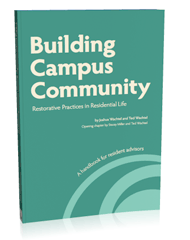 IIRP now has a brand new book, Building Campus Community: Restorative Practices in Residential Life. I co-wrote the book with Ted Wachtel, and the introductory chapter was co-written by Stacey Miller, University of Vermont Director of Residential Life, and Ted Wachtel.
IIRP now has a brand new book, Building Campus Community: Restorative Practices in Residential Life. I co-wrote the book with Ted Wachtel, and the introductory chapter was co-written by Stacey Miller, University of Vermont Director of Residential Life, and Ted Wachtel.
Here are a couple excepts from Chapter 3 discussing the special role of the RA and how Restorative Practices can help balance the ideals of being a community leader with the need to also enforce behavioral norms:
- Details
- Written by Joshua Wachtel
This week I'll be featuring different links related to IIRP's newest project, Building Campus Community. This project helps campuses apply the full spectrum of restorative practices at the college and university level, beginning specifically with residence halls. Restorative practices gives resident advisors (RA's) a wide range of tools for both building community proactively and responding to harm and wrongdoing when it occurs.
By way of introduction, here are two videos from administrators and RA's at the University of Vermont, a campus currently in its second year of RP implementation for residence halls across the entire campus.
- Details
- Written by Joshua Wachtel
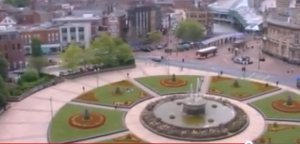 This piece was written by John Macdonald discussing Hull, UK's project to become the world's first restorative city by implementing restorative practices throughout the city for public service agencies working with youth, including schools and police. He makes the case that private business would do well to examine restorative practices as a leadership model. The article first appeared under the title "Restoring Your Bottom Line: Restorative Practices in the Business Environment."
This piece was written by John Macdonald discussing Hull, UK's project to become the world's first restorative city by implementing restorative practices throughout the city for public service agencies working with youth, including schools and police. He makes the case that private business would do well to examine restorative practices as a leadership model. The article first appeared under the title "Restoring Your Bottom Line: Restorative Practices in the Business Environment."
IIRP has worked extensively with Hull, conducting trainings and offering materials that Hull uses for its trainings. Read more about Hull's efforts to become a restorative city here.
- Details
- Written by Joshua Wachtel
March 6 & 7, 2012, 8:30 AM – 4:00 PM
Hosted by: Lancaster Catholic High School, 650 Juliette Avenue, Lancaster, PA
Two in-service days offered in the SaferSanerSchools Whole-School Change Program
Introduction to Restorative Practices — $140 Tuesday, March 6, 2012 — Register here.
Ideally paired with Using Circles Effectively
- Details
- Written by Joshua Wachtel
Last week I linked to a blog post by Photographer Matt Roth about City Springs Elementary/Middle School in Baltimore and their successful use of Restorative Practices for dealing with safety issues. Today I'm reposting a piece about the Baltimore Curriculum Project, which discusses the history and context of their adoption of Restorative Practices. The original post can be found here.
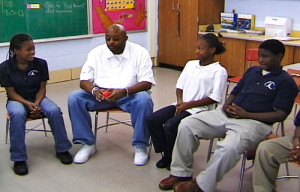 In the fall of 2005 Baltimore Curriculum Project (BCP) President Muriel Berkeley attended a workshop at the Maryland Charter School Network Conference that sparked a wholesale transformation of school culture at BCP's four neighborhood charter schools: City Springs School, Collington Square School of the Arts, Hampstead Hill Academy, and Wolfe Street Academy.
In the fall of 2005 Baltimore Curriculum Project (BCP) President Muriel Berkeley attended a workshop at the Maryland Charter School Network Conference that sparked a wholesale transformation of school culture at BCP's four neighborhood charter schools: City Springs School, Collington Square School of the Arts, Hampstead Hill Academy, and Wolfe Street Academy.
- Details
- Written by Joshua Wachtel
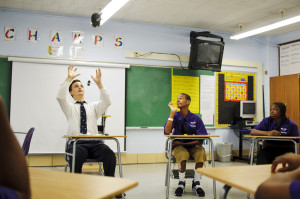 Photographer Matt Roth posted some lovely photos recently on his blog, part of a photo shoot for an article that appeared in Education Week last summer.
Photographer Matt Roth posted some lovely photos recently on his blog, part of a photo shoot for an article that appeared in Education Week last summer.
The quote that stands out for me is this one, a candid impression of what it felt like to spend time in City Springs Elementary/Middle School, a school that is part of the Baltimore Curriculum Project and with whom IIRP has worked extensively:
- Details
- Written by Joshua Wachtel
"We must also propose new ways of life ... that means shifting from a punitive mindset to a restorative one."
I'm working on a new eForum article about a program called FaithCARE which applies restorative practices to faith communities and congregations. I've recently had the opportunity to interview Mark Vander Vennen of Shalem Mental Health Network in Ontario, Canada about this project and to talk to Bruce Schenk of IIRP Canada again, who partners with Shalem and has been very active in developing the program.
So it was pleasant to see this piece by Mark which discusses the need for restorative responses in light of a "tough-on-crime" law currently moving its way through the Canadian legislature. I'm reposting the article below, but the original piece can be found in Northumberland Today by clicking here.
- Details
- Written by Samantha White
|
When challenging behavior:
|
To help those affected:
|
| Purchase packs of 100 "Restorative Questions Cards. |
|
- Details
- Written by Joshua Wachtel
As a followup to Wednesday's post about the upcoming student-led initiative in Philadelphia - "End Violence Through Restorative Justice" - organized by The Campaign for Nonviolent Schools on Martin Luther King Day January 16, here is a video that recaps last October's Week of Action Against School Pushout. This video highlights how students and members of the community across the country are increasingly speaking out to promote positive alternatives to zero-tolerance policies, including restorative practices. The first three minutes features many youth voices speaking about their experiences. At minute 6:15 mention is made of The Campaign for Nonviolent Schools' Youth Speakout Against Pushout which happened in Philadelphia that week.
"Throughout the week of October 1-8, 2011, thousands of parents, youth, and educators took part in student-led actions and events in 28 cities to expose the school pushout crisis in our nation and advocate for the human right of every young person to a quality education and to be treated with dignity. The events and actions included street theater, public forums, rallies, restorative justice trainings, and more.
- Details
- Written by Joshua Wachtel
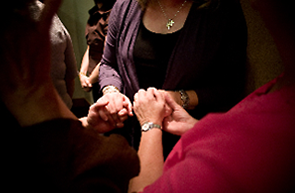 Here's a post written by Sylvia Clute on her Genuine Justice blog and based on a workshop she attended at IIRP's 14th Conference in Nova Scotia last summer. The workshop was given by Susannah Sheffer and Walter Long, who both advocate for abolishing the death penalty. Sylvia has written about several talks given at the conference, which she has given me permission to re-post. I begin with this one because of a personal connection:
Here's a post written by Sylvia Clute on her Genuine Justice blog and based on a workshop she attended at IIRP's 14th Conference in Nova Scotia last summer. The workshop was given by Susannah Sheffer and Walter Long, who both advocate for abolishing the death penalty. Sylvia has written about several talks given at the conference, which she has given me permission to re-post. I begin with this one because of a personal connection:
I met Susannah Sheffer the other month when I began a new part-time job at North Star Self-Directed Learning for Teens, a community-based education center for teens seeking to pursue their own learning path outside traditional channels. I noticed that Susannah was offering a weekly class called "Harm and Punishment" which smacked of restorative approaches. When I asked her about it she said that she'd presented at Halifax. I said I'd thought I'd come across Sylvia Clute's post about her work, and we've been having conversations about restorative justice and restorative practices ever since.

Restorative Works Year in Review 2024 (PDF)
All our donors are acknowledged annually in Restorative Works.
